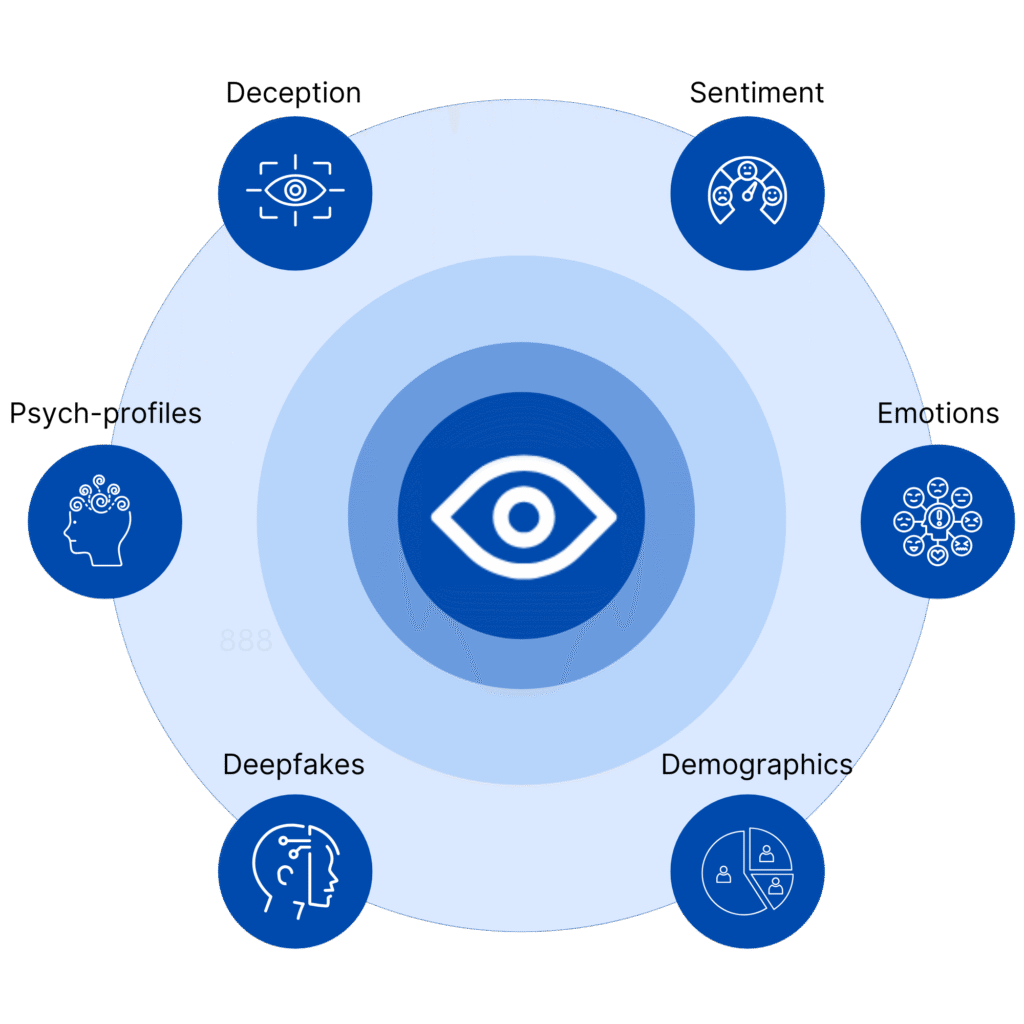PolygrAI's Technology
An Innovative Approach Towards Human Behavioral Analysis
Our Analysis Core
Deception detection has existed for decades, but it has only now began to be empowered by AI and neural networks. We aim to be at the forefront of these developments, which are set to disrupt past beliefs/approaches.
-
Computer Vision
Extracts facial behaviors and nonverbal cues from video recordings using advanced visual algorithms.
-
Audio Parametrization
Converts audio into mel spectrograms to analyze pitch, tone, and speech dynamics.
-
Transcription
Automatically transcribes speech to text for detailed linguistic analysis and statement-by-statement segmentation.
-
LLM Analysis Interpretation
Uses large language models to interpret data and generate human-friendly analytical summaries.
Approach
-
1. CAPTURE
Capture behavioral cues in real time across visual audio and linguistic channels to build a complete picture of intent. This continuous AI powered monitoring reveals markers of engagement stress or deception and fuels smarter risk assessment and decision making.
-
2. LEARN
Learn each person’s natural baseline within the first seconds of an interview for precise comparison. By establishing early individual norms our system detects subtle deviations in behavior that inform accurate authenticity scoring.
-
3. DETECT
Instantly flag unusual patterns or covert signals that may indicate deception or hidden intent. These automated alerts empower hiring teams and investigators to focus on high risk moments and reduce false positives.
-
4. SEGMENT
Break each response into individual statements for rapid focused analysis of key moments. This granular approach lets you isolate critical vocal eye and linguistic cues and improves the accuracy of behavioral assessments.
-
5. EVALUATE
Deliver clear risk ratings and actionable insights so you can decide with confidence. Combined with AI driven analytics these scores provide a transparent framework for objective personality profiling and fraud detection.
Analysis Modalities
01
Visual Analysis
PolygrAI’s visual intelligence engine uses computer vision to track facial expressions eye movements gestures and micro expressions frame by frame into quantifiable data. This combined analysis enriches assessments by flagging authenticity indicators and risk factors with reliable accuracy.
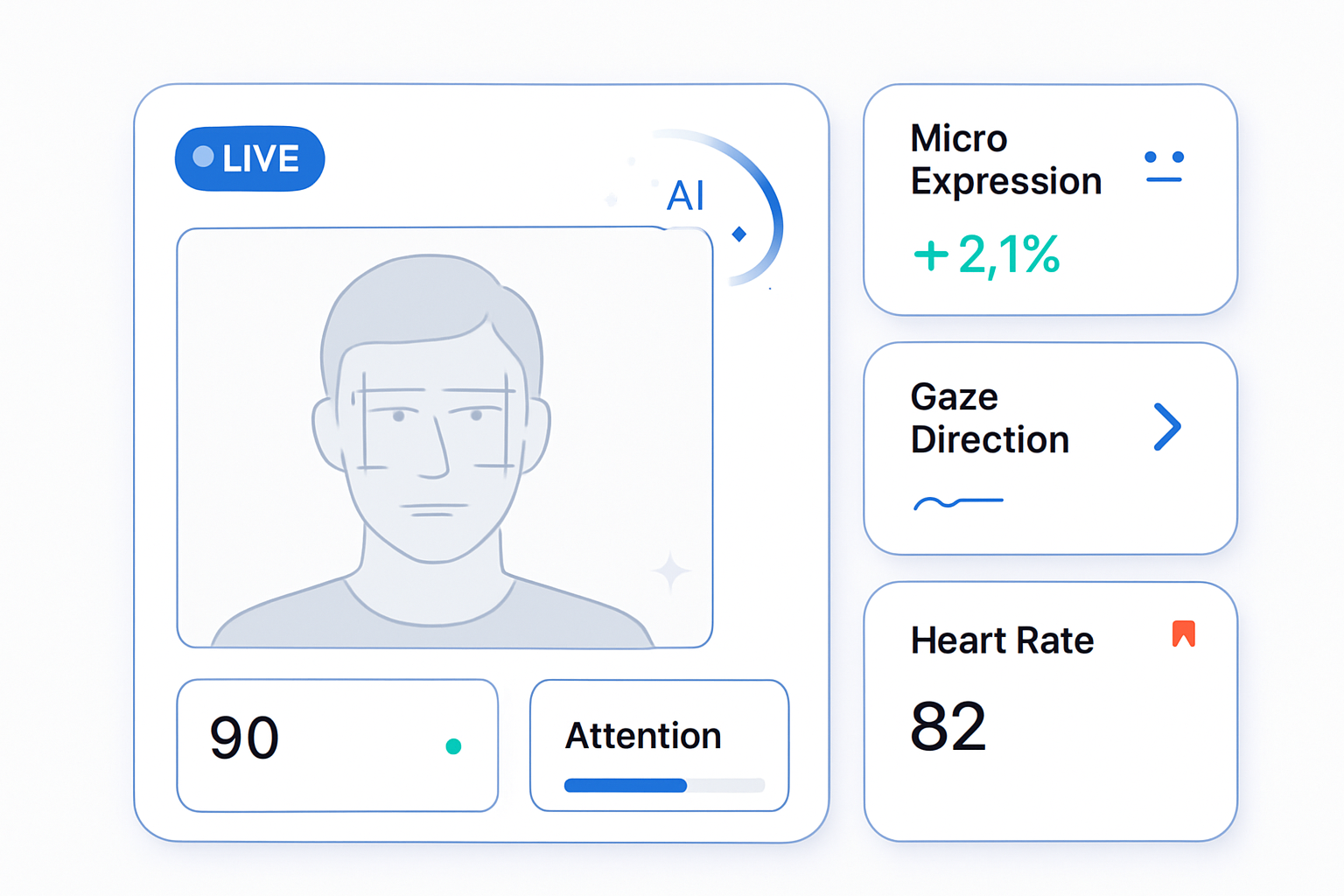
02
Voice Analysis
PolygrAI captures subtle vocal cues such as pitch shifts pauses and stress patterns to surface markers of confidence deception or emotional state in real time. These insights replace guesswork with objective data under strict privacy first controls.
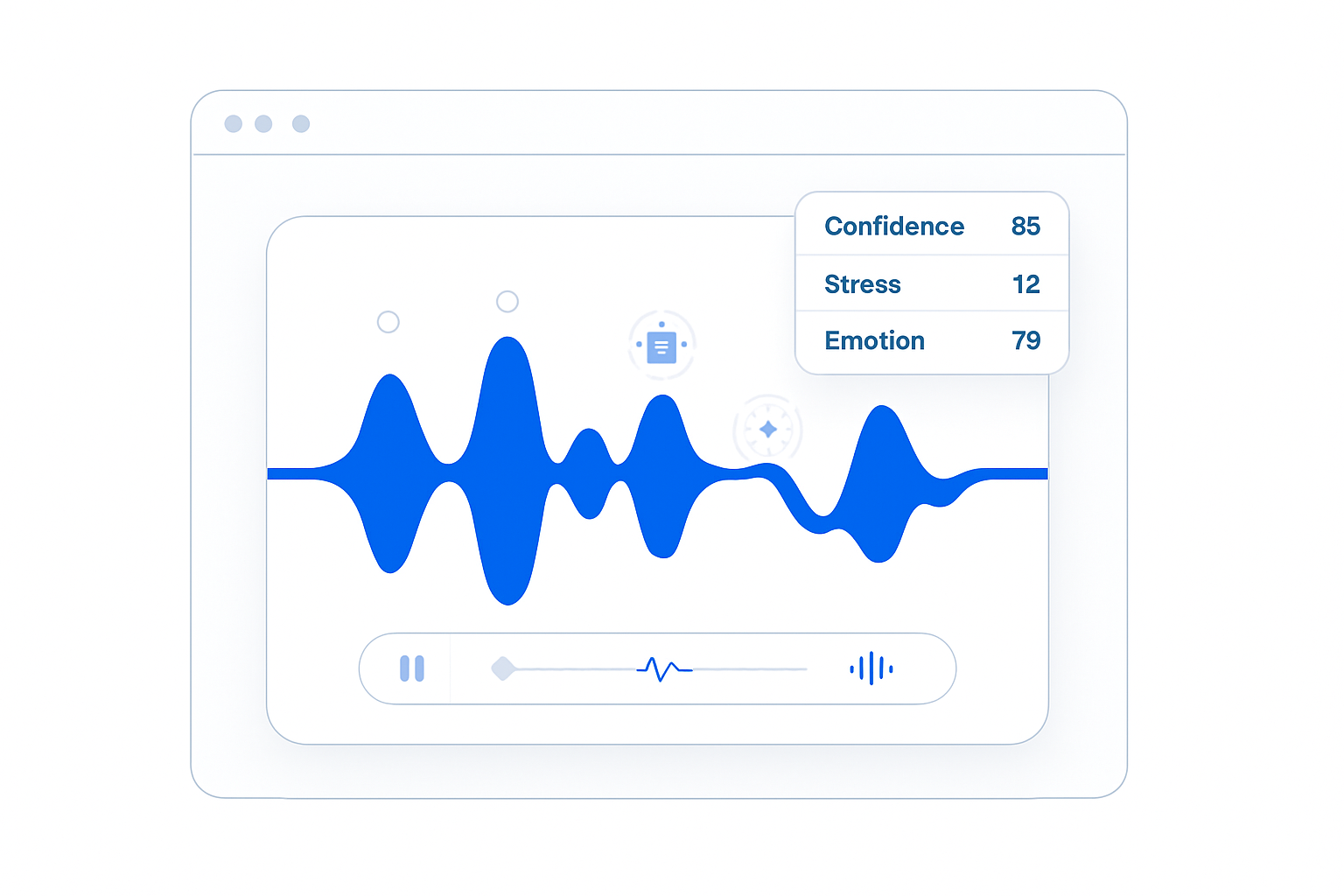
03
Linguistic Analysis
PolygrAI harnesses AI to fuse speech cues facial micro expressions and response timing with validated psychometric frameworks to reveal personality traits emotional stability and risk appetite. This context aware approach delivers scalable behavioral insights without traditional testing.
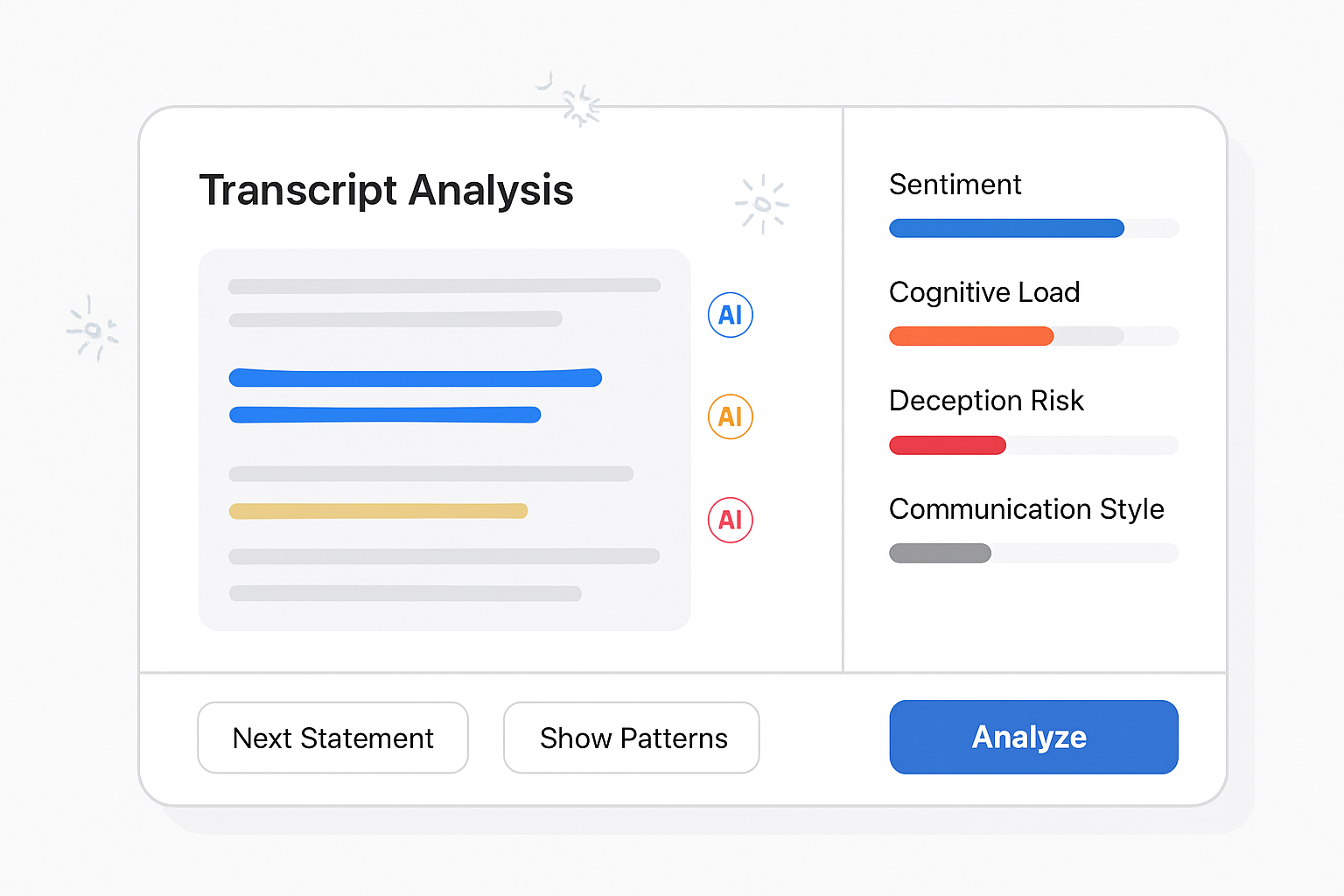
04
Psychological Analysis
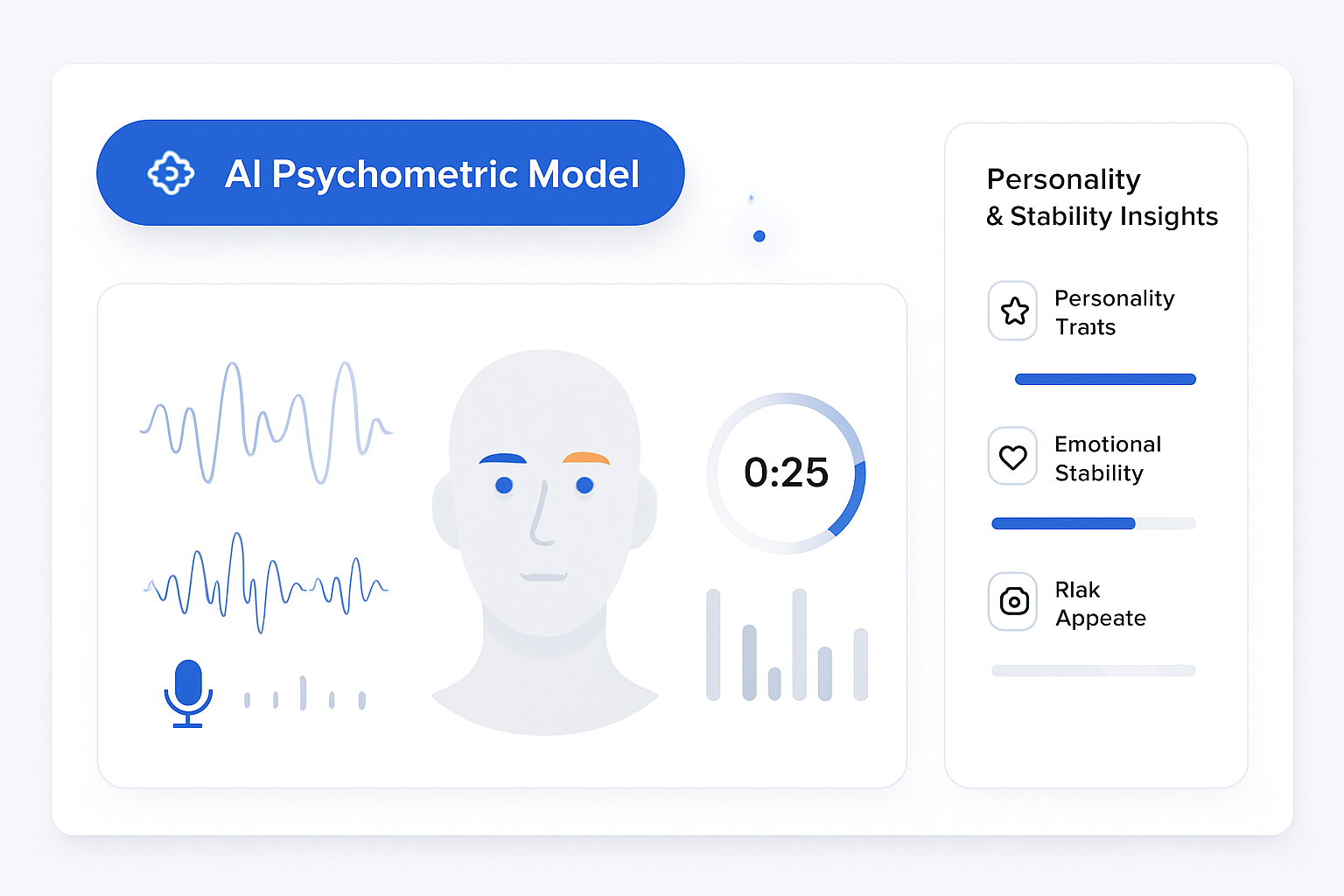
Cues we're looking For
Visual Modality
Heart Rate
Rapid Spikes & Drops
Blinking
Altered blink rate frequency
Eye Gaze
Shifted eye gaze direction
Risk Emotions
Detected elevated risk emotion
Hands on Face
Hand touches face
Head Orientation
Altered head orientation angle
Looked Up/Down
Glance up or down
Audio Modality
Pitch Changes
Sudden pitch spike
Volume Changes
Rapid Spikes, Drops
Speech Rate Changes
Rapid speech variation
Extended Pauses
Lengthy silent gap
Linguistic Modality
Risk Words
Risk-indicating words
Filler Words
Frequent filler usage
Suspicious Phrases
Abnormal phrase patterns
Negation Use
Excessive negative words
Psychological Modality
MBTI Personality Type
Personality classification system
Attachment Style
Patterns of relational bonding
Light/Dark Triad
Spectrum of personality traits
Deception Detection Research
Explore research into the science and technology behind lie detection, covering facial micro expressions, voice stress signals, word pattern analysis and brain activity insights that empower PolygrAI’s truth detection.
Deception detection using machine learning (ML) and deep learning (DL) techniques
Catching a Liar Through Facial Expression of Fear
Deception detection with machine learning: A systematic review and statistical analysis
A Review of Automatic Lie Detection from Facial Features
Deception detection using machine learning (ML) and deep learning (DL) techniques
Social Impact and Privacy Stance
We do not collect user data for training purposes and we are striving to make a positive impact with our technology
FAQs
What is PolygrAI and how does it work?
PolygrAI is an AI-driven behavioral analysis company that applies advanced computer vision, audio processing and natural language understanding to everyday video and audio recordings. Its proprietary deep-learning models, trained on thousands of hours of real human interactions, detect subtle facial microexpressions, vocal stress variations, eye-gaze dynamics and linguistic nuances. By fusing these multimodal signals, PolygrAI delivers a reliable measure of truthfulness alongside rich emotional and demographic insights—all without specialized hardware or in-person examinations.
The PolygrAI Web App provides a secure, intuitive interface for uploading recordings and receiving a comprehensive, interactive report. Within moments, users can explore truthfulness scores, sentiment timelines and emotional breakdowns alongside charts of heart-rate fluctuations, voice analytics, attention levels and interactivity metrics. Integrated personality and attachment-style profiles complete the analysis, empowering teams in hiring, security, fraud prevention and investigative workflows to make data-driven decisions with clarity and confidence.
How accurate is PolygrAI?
As the AI-powered, multimodal system learns and undergoes ongoing refinements during active development. By integrating more behavioural and physiological cues than a traditional polygraph, we expect it to surpass conventional systems over time, offering ever more reliable insights when used alongside human judgment.
What behavioral and physiological cues does PolygrAI analyze?
The system processes facial microexpressions, body gestures, heart rate fluctuations, eye gaze shifts, vocal pitch and pause patterns, linguistic markers and sentiment tone against each person’s baseline.
How does PolygrAI detect deepfakes?
We partner with TrueLens, a joint venture specializing in deepfake detection. TrueLens employs an ensemble of neural network models that analyze facial micro-expressions, texture inconsistencies, voice signal artifacts and metadata anomalies. This multi-model approach accurately distinguishes genuine subjects from synthetic content and flags suspicious recordings for your review.
What psych profile insights does PolygrAI provide?
Psychological profiling combines psychometric modelling, semantic emotion analysis and behavioural cue detection to infer key personality traits, relational dynamics and motivational drivers. By integrating MBTI personality type assessments, attachment style evaluations and light and dark triad frameworks, PolygrAI creates comprehensive profiles that reveal individual strengths, interpersonal tendencies and potential risk indicators for more informed evaluations.
How is my privacy protected?
All processing occurs upon session upload without storing personal video, audio or transcripts and no data is retained for training. We follow GDPR guidelines and use industry-standard encryption to safeguard your information. You can request data deletion at hello@polygr.ai.
How do you calculate the AI Score?
The AI Score harnesses a sophisticated language model to interpret your custom evaluation criteria together with the complete behavioral analysis report. It examines sentiment trends, linguistic nuances, behavioral indicators and psychological profile data to generate a cohesive narrative summary and distill all of these insights into a single percentage. This unified score delivers immediate clarity on how well an interaction aligned with your goals, making it simple to compare performances and drive more informed decisions.
Web and Mobile Access?
You can access PolygrAI from any modern browser and soon from your phone or tablet for uploaded session analysis.
What integrations are supported?
Our API for integrating PolygrAI into your workflows covering video upload, data export and single sign on is under development and expected to launch soon. Contact us at hello@polygr.ai for more information.
DISCLAIMERS
PolygrAI will never reach absolute accuracy and it's illegal to use without consnet
While our technology provides valuable insights into potential risks, it’s crucial to understand that human behavior is inherently complex and unpredictable. Our system is designed to assist users by offering data-driven assessments that aid interpretation, but it should not be viewed as a conclusive determination of truth.
Users are encouraged to consider PolygrAI’s analysis as one part of a broader evaluation process, complementing other information and judgment. Always prioritize ethical use and respect individual privacy and rights.
Yet, it can still make a difference
Despite inherent limitations, our ongoing research and development efforts are focused on refining our system’s accuracy and utility to better serve our users and enhance its impact.
As an AI-powered, multimodal platform under active development that integrates more behavioral and physiological cues than traditional polygraphs, we expect our technology to surpass conventional systems over time, offering increasingly reliable insights when used alongside human judgment.
